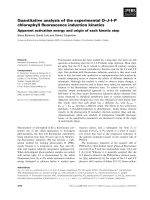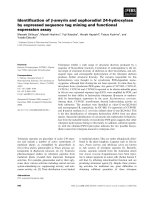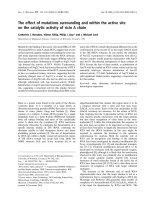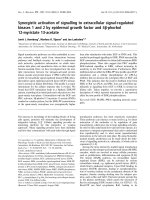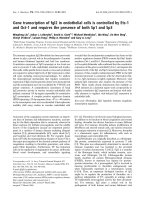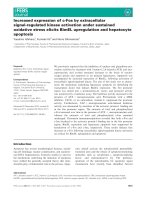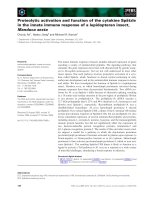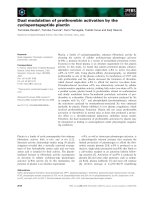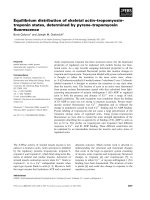Báo cáo khoa học: Proteolytic activation of internalized cholera toxin within hepatic endosomes by cathepsin D doc
Bạn đang xem bản rút gọn của tài liệu. Xem và tải ngay bản đầy đủ của tài liệu tại đây (474.97 KB, 13 trang )
Proteolytic activation of internalized cholera toxin within
hepatic endosomes by cathepsin D
Cle
´
mence Merlen*, Domitille Fayol-Messaoudi*, Sylvie Fabrega, Tatiana El Hage, Alain Servin
and Franc¸ois Authier
Institut National de la Sante
´
et de la Recherche Me
´
dicale U510, Faculte
´
de Pharmacie Paris XI, Cha
ˆ
tenay-Malabry, France
Cholera toxin (CT) produced by Vibrio cholerae is
the major virulence factor responsible for the massive
secretory diarrhea of infected humans [1]. CT interacts
with intestinal epithelial cells and induces chloride
secretion due to toxin-mediated activation of adenylate
cyclase and elevation of intracellular cAMP. Activation
of adenylate cyclase results from ADP-ribosylation of
Arg201 of the a-subunit of the stimulatory GTP-binding
regulatory protein, Gsa, catalyzed by the toxin [2].
CT ( 84 kDa) is an oligomeric protein of the A-B
type composed of one activating A subunit (CT-A,
r.m.m. 27 400 Da) and five identical B subunits (CT-B,
r.m.m. 11 600 Da) arranged in a ring-like configur-
ation that bind ganglioside GM1 at the cell surface [3].
The CT-A subunit is comprised of two functional
domains termed the A1 and A2 peptides linked by
a single disulfide bond. The A1 peptide exhibits the
toxin’s ADP-ribosyltransferase activity which is neces-
sary for CT cytotoxic action. The A2 peptide contains
the endoplasmic reticulum-targeting motif KDEL at its
C-terminus. For full ADP-ribosylation of the stimula-
tory heterotrimeric GTPase Gsa, enzymatic production
of a degradative fragment generated from native CT
and structurally related to the A1 peptide must occur
followed by its targeting to the Gsa substrate. This
process, which takes 30–40 min in most cell types,
Keywords
cathepsin D; cholera toxin; endocytosis;
hepatocyte; proteolysis
Correspondence
F. Authier, INSERM U510, Faculte
´
de
Pharmacie Paris XI, 5 rue Jean-Baptiste
Cle
´
ment, 92296 Cha
ˆ
tenay-Malabry, France
Fax: +33 1 46835844
Tel: +33 1 46835843
E-mail:
*These authors contributed equally to the
paper
(Received 29 April 2005, revised 1 July
2005, accepted 7 July 2005)
doi:10.1111/j.1742-4658.2005.04851.x
We have defined the in vivo and in vitro metabolic fate of internalized chol-
era toxin (CT) in the endosomal apparatus of rat liver. In vivo, CT was
internalized and accumulated in endosomes where it underwent degrada-
tion in a pH-dependent manner. In vitro proteolysis of CT using an endo-
somal lysate required an acidic pH and was sensitive to pepstatin A, an
inhibitor of aspartic acid proteases. By nondenaturating immunoprecipita-
tion, the acidic CT-degrading activity was attributed to the luminal form of
endosomal cathepsin D. The rate of toxin hydrolysis using an endosomal
lysate or pure cathepsin D was found to be high for native CT and free
CT-B subunit, and low for free CT-A subunit. On the basis of IC
50
values,
competition studies revealed that CT-A and CT-B subunits share a com-
mon binding site on the cathepsin D enzyme, with native CT and free
CT-B subunit displaying the highest affinity for the protease. By immuno-
fluorescence, partial colocalization of internalized CT with cathepsin D was
confirmed at early times of endocytosis in both hepatoma HepG2 and
intestinal Caco-2 cells. Hydrolysates of CT generated at low pH by bovine
cathepsin D displayed ADP-ribosyltransferase activity towards exogenous
Gsa protein suggesting that CT cytotoxicity, at least in part, may be rela-
ted to proteolytic events within endocytic vesicles. Together, these data
identify the endocytic apparatus as a critical subcellular site for the accu-
mulation and proteolytic degradation of endocytosed CT, and define endo-
somal cathepsin D an enzyme potentially responsible for CT cytotoxic
activation.
Abbreviations
CT, cholera toxin; EN, endosomes; HI, human insulin; PA, pepstatin-A; PDI, protein disulfide isomerase.
FEBS Journal 272 (2005) 4385–4397 ª 2005 FEBS 4385
corresponds to the lag-phase required for CT to enter
the cell by endocytosis using clathrin-dependent and
-independent mechanisms [4,5], become activated and
move to its site of action.
Two major candidate compartments have been
proposed as being physiologically relevant to the
mechanism of activation of internalized CT. The first
activating pathway, identified in rat hepatocytes, has
been proposed to operate at an early stage of endo-
cytosis within endocytic vesicles [6,7]. Thus, using a
subcellular fractionation approach to address CT
compartmentalization and activation in vivo, it was
shown that activation of adenylate cyclase by CT in
intact liver requires the association and subsequent
processing of the toxin in an endosomal compart-
ment. However, the nature of the relevant enzymatic
activity (protease and ⁄ or reductase) as well as the
mechanisms underlying CT-A subunit cytotoxic
action towards its substrate were not investigated.
The other well-characterized subcellular compart-
ment involved in CT activation is the endoplasmic reti-
culum (ER) where CT is transported in a retrograde
manner via the Golgi apparatus by a KDEL-dependent
mechanism [8]. After entry of CT into the ER, the
ER-chaperone protein disulfide isomerase (PDI) is
involved in facilitating the reduction of the internal
disulfide bond of CT [9] and preparation of the A1
peptide for retro-translocation to the cytosol by the
Sec61p channel [10].
In the present study, we have characterized the
endosomal processing of endocytosed CT in rat liver
and examined the sensitivity of toxin proteolysis to
pH, protease inhibitors and immunodepletion pro-
cedures using antibodies to well-defined endosomal
proteases. In addition, using a cell-free ADP-ribosyla-
tion assay, we have explored the potential physiologi-
cal significance of the endosomal proteolysis of CT in
its cytotoxic action. This has allowed us to characterize
the role of the aspartic acid protease cathepsin D in
the endosomal degradation of internalized CT. We
show that hydrolysates of CT generated in vitro by
pure cathepsin D displayed ADP-ribosyltransferase
activity towards exogenous Gsa protein.
Results
In vivo endocytosis of native CT and CT-B
subunit in rat liver
The kinetics of in vivo uptake of native CT and CT-B
subunit into endosomal fractions were first assessed
(Fig. 1). Rats were administered an intravenous injec-
tion of native CT or CT-B subunit (50 lg per 100 g
body weight) and killed 5–90 min postinjection.
Following preparation of hepatic endosomes the
amount of internalized CT-A and CT-B subunits was
determined by western blot analyses (Fig. 1A). A simi-
lar time-dependent increase in CT-A and CT-B
A
B
Fig. 1. Kinetics of appearance of CT-A and
CT-B subunits in hepatic endosomes after
ligand administration. (A) Endosomal frac-
tions were isolated at the indicated times
after the in vivo administration of native CT
or CT-B subunit, and evaluated for their con-
tent of both subunits by western blot analy-
sis using the polyclonal anti-CT Ig. Each lane
contained 50 lg of endosomal protein.
Arrows to the right indicate the mobility of
CT-A ( 28 kDa) and CT-B subunit
( 12 kDa). Molecular mass markers are
indicated to the left of each blot. (B) Assess-
ment of polyclonal antibody specificity
towards CT and individual A- and B-subunits
was performed using reducing and non-
reducing SDS ⁄ PAGE followed by western
blot analysis. Each lane contained 1 lgof
peptide. Arrows to the right indicate the
mobility of CT-A ( 28 kDa), CT-B ( 12 kDa),
and A1 peptide ( 21 kDa). A2 peptide was
not detected under these experimental
conditions. Molecular mass markers are
indicated to the left of each blot.
Endosomal proteolysis of cholera toxin by cathepsin D C. Merlen et al.
4386 FEBS Journal 272 (2005) 4385–4397 ª 2005 FEBS
subunits was observed in endosomal fractions 5–30 min
after native CT injection (Fig. 1A, upper blot), after
which the level of both subunits decreased. A slower rate
of B-subunit endocytosis was observed in response to
CT-B subunit administration and remained elevated up
to 90 min postinjection (Fig. 1A, lower blot).
Characterization of the polyclonal anti-CT antibody
C3062 by western blot analysis of pure CT or individ-
ual A- and B-subunits revealed a specificity for both
subunits under nonreducing conditions (Fig. 1B, upper
blot). Following chemical reduction of the A-subunit
interchain disulphide bond, the rabbit anti-CT anti-
body recognized the A1 peptide and B-subunit with no
immunoreactivity towards the A2 peptide (Fig. 1B,
lower blot).
Proteolysis of CT within hepatic endosomes
at acidic pH
We next examined the ability of hepatic endosomes
to degrade CT (Fig. 2). The luminal and membrane-
bound distribution of endosomal CT-degrading activity
was assessed by western blot analysis of CT digestions
performed at various pH (Fig. 2A). EN fractions
degraded native CT at pH 4 and 5, with degradation
decreasing markedly at pH 6–7. The CT-B subunit was
more efficiently degraded than the CT-A subunit
(Fig. 2A, EN, lane pH 4). A 25-kDa proteolytic frag-
ment of CT-A subunit was specifically generated at
pH 4–5. Another CT-A product of 22-kDa was
observed in hydrolysates at pH 6–7 and also in the
untreated toxin (lane -). Subfractionation of hepatic
endosomes (EN) into a soluble endosomal lysate (ENs)
revealed a similar pattern of proteolysis to that
observed for the EN fraction (Fig. 2A, ENs), suggest-
ing that the majority of CT-degrading activity in endo-
somes is soluble.
A soluble endosomal extract (ENs) was then assessed
by HPLC analysis for its ability to proteolyze native CT
in vitro at acidic (pH 4 and 5) and neutral pH (pH 7)
(Fig. 2B). Degradation of both A- and B-subunits was
pH-dependent with maximal degradation obtained at
A
B
Fig. 2. Effect of pH on the endosomal pro-
cessing of native CT. (A) Total (EN 10 lg)
and soluble endosomal fractions (ENs
1 lg) were incubated with 7 lg native CT
at 37 °C for 60 min in 30 m
M citrate-phos-
phate buffer at the indicated pH. The incu-
bation mixtures were then analyzed by
western blotting using the polyclonal anti-CT
antibody. The mobility of each CT subunit is
indicated on the right (CT-A 28 kDa; CT-B,
12 kDa). (B) Representative RP-HPLC pro-
files obtained by incubating native CT (1 l
M)
with ENs ( 1 lg) at 37 °C for 60 min in
175 m
M citrate-phosphate buffer at the
indicated pH. Shown are absorbance profiles
at 214 nm. Untreated CT subunits had an
elution time of 60 min (CT-B) and 63 min
(CT-A) (HPLC profile CT). The endosomal
proteins alone did not give any detectable
peaks (results not shown).
C. Merlen et al. Endosomal proteolysis of cholera toxin by cathepsin D
FEBS Journal 272 (2005) 4385–4397 ª 2005 FEBS 4387
pH 4. Intermediate peptide peaks were only observed
at pH 4 in addition to the undegraded subunits which
had decreased in peak height (Fig. 2B).
Catalytic properties of endosomal CT-degrading
activity
We evaluated the ability of individual CT-A and CT-B
subunits to act as substrates for endosomal acidic pro-
teases (Fig. 3). The rate of hydrolysis of individual
subunits was determined using RP-HPLC analysis by
following the disappearance of the parent peptide after
a 2 h incubation with ENs at pH 4 (Fig. 3, lower pan-
els). The rate of peptide hydrolysis was found to be
very low with free CT-A subunit and high with free
CT-B subunit. However, when native CT was used as
a substrate the rates of proteolysis of both subunits pre-
sent in the AB
5
pentamer were comparable to that of
the individual CT-B subunit (Fig. 3, lower panel, left).
The effect of various protease inhibitors on the aci-
dic CT-degrading activity contained in hepatic endo-
somes was next examined by western blot and HPLC
analyses (Fig. 4). The proteolytic activity directed
against both A- and B-subunits at pH 4 was inhibited
by pepstatin-A (PA), an inhibitor of aspartic acid pro-
teases (Fig. 4A, PA). No effect was observed with the
cysteine-protease inhibitor E-64 or the metal-chelating
agent EDTA. The 25-kDa proteolytic fragment of the
CT-A subunit, whose level was maximal after a 3 h
incubation, was not detected in the presence of pepsta-
tin-A. Two minor diffuse CT-A fragments of 22- and
18-kDa were also observed after 3 h of incubation,
however, their production was inhibited in the pres-
ence of pepstatin-A (for the 18-kDa species) or EDTA
(for the 22- and 18-kDa species). RP-HPLC analysis
of CT digestions performed at pH 4 using the ENs
fraction confirmed the inhibitory effect of pepstatin-A,
with no significant effect observed using E-64 and the
serine protease inhibitor PMSF (Fig. 4B,C).
Identification of endosomal CT-degrading
enzyme as cathepsin D
The inhibition of CT-degrading activity by pepstatin-
A, its low pH optimum and its presence in the endo-
somal lumen as a soluble form suggested cathepsin D
as a likely candidate for this activity. We therefore
used well characterized polyclonal antibodies to
mature cathepsin D and its proform [11,12] to deplete
cathepsin D from ENs (Fig. 5A). Quantitative immuno-
precipitation of cathepsin D using antibodies direc-
ted against the mouse (R291) and human enzyme
(M8147) removed greater than 88% of the endosomal
proteolytic activity directed towards both subunits
as assessed by RP-HPLC (Fig. 5B). Immunodeple-
tion of ENs with antibodies to cathepsin B and its
Fig. 3. Kinetics of proteolysis of native CT, CT-A subunit and CT-B subunit at pH 4 by a soluble endosomal lysate. Shown are representative RP-
HPLC profiles resulting from the incubation of native CT, CT-A or CT-B (1 l
M) with ENs ( 1 lg) at 37 °C for 120 min in 175 mM citrate-phos-
phate buffer pH 4 (lower HPLC profiles). Shown are absorbance profiles at 214 nm. Elution profiles of native CT and individual CT-A and -B
subunits are shown for comparison (upper HPLC profiles).
Endosomal proteolysis of cholera toxin by cathepsin D C. Merlen et al.
4388 FEBS Journal 272 (2005) 4385–4397 ª 2005 FEBS
proform [13] failed to remove the proteolytic activity
(Fig. 5A).
To strengthen the physiological relevance of our
observations obtained in vitro with cell-free endosomes,
we studied the subcellular localization of internalized
CT or CTB-FITC and cathepsin D in hepatoma HepG2
and intestinal Caco-2 cells by immunofluorescence con-
focal microscopy (Fig. 6). Cells were incubated with
1 lm native CT for 30 min (HepG2 cells) or CTB-FITC
for 15 min (HepG2 and Caco-2 cells) when most of the
internalized ligands would be located in the endosomes
(Fig. 1A). CTB-FITC and monoclonal antibody D15-8
to the CT-B subunit (in green) demonstrated a highly
punctate staining pattern reminiscent of vesicular com-
partments. Costaining with antibody directed against
mature and precursor cathepsin D enzyme (in red)
revealed a partial colocalization (in yellow) of CT with
the intracellular aspartic acid protease.
Affinity-binding and degradation of native CT and
individual CT subunits by cathepsin D
Substrates of the same protease would be expected to
compete with each other for the enzyme binding site.
We therefore used a competition assay to evaluate
the ability of native CT and the individual A- and
B-subunits to inhibit degradation of the radiolabeled
substrate
125
I-labelled Tyr
A14
-HI by cathepsin D
(Fig. 7A). As reported previously [12,14], the well-
defined cathepsin D substrate HI was found to inhibit
A
C
B
Fig. 4. Effect of protease inhibitors on the proteolysis of native CT by hepatic endosomes. (A) EN fraction was incubated with 7 lg native
CT at 37 °Cfor1or3hin30m
M citrate-phosphate buffer pH 4 without (buffer) or with 1% Me
2
SO (DMSO), 3.5 lgÆmL
)1
pepstatin-A (PA),
0.1 m
M E-64 or 1 mM EDTA. At the end of the incubation, the samples were analyzed by western blotting using the polyclonal anti-CT Ig.
Molecular mass markers are indicated to the left of each panel. Arrows indicate the mobility of the intact A ( 28 kDa) and B subunits
( 12 kDa). (B) Representative RP-HPLC profiles obtained following the incubation of native CT with ENs in the presence or absence of
3.5 lgÆmL
)1
pepstatin-A. Shown are absorbance profiles at 214 nm. Elution profile of native CT is shown for comparison (HPLC profile CT).
(C) ENs ( 1 lg) was incubated with 1 l
M native CT at 37 °C for 60 min in 175 mM citrate-phosphate buffer pH 4 in the absence or pres-
ence of 3.5 lgÆmL
)1
pepstatin-A (PA), 1% Me
2
SO (DMSO), 1 lM E-64, 1 mM PMSF or 1% MeOH. At the end of the incubation, the proteo-
lytic reaction was stopped with acetic acid (15%), and the incubation mixtures were analyzed by RP-HPLC. The rate of proteolysis of CT-A
and CT-B subunits was determined by following the disappearance of the peak area corresponding to the parent peptides.
C. Merlen et al. Endosomal proteolysis of cholera toxin by cathepsin D
FEBS Journal 272 (2005) 4385–4397 ª 2005 FEBS 4389
125
I-labelled Tyr
A14
-HI proteolysis by bovine cathepsin
D in a dose-dependent manner with an IC
50
of 30 lm.
Native CT was 50 times more effective than HI at
competing for proteolysis of radiolabeled HI (IC
50
of
0.6 lm). The CT-B subunit (IC
50
of 0.9 lm) was able
to inhibit the degradation of radiolabeled HI compar-
ably to that of native CT, whereas the CT-A subunit
(IC
50
of 9 lm) was found to be 10–15 times less
potent than native CT.
We then compared the rate of hydrolysis of the indi-
vidual CT-A and CT-B subunits by cathepsin D at
pH 4, followed by nonreducing SDS ⁄ PAGE and Coo-
massie Blue staining (Fig. 7B). Pure cathepsin D was
found to degrade the CT subunits in a manner similar
to that observed for the hepatic endosomal fractions
(Fig. 2A), i.e. CT-B subunit (t
1 ⁄ 2
< 15 min) > CT-A
subunit (t
1 ⁄ 2
60 min).
Proteolytic activation of CT induced by
cathepsin D treatment
CT cleavage induced by cathepsin D may be an essen-
tial step for the cytotoxic activity of the toxin. Conse-
quently, we examined whether under conditions where
CT was partially processed by cathepsin D, we would
observe a corresponding change in the toxin cytotoxi-
city (Fig. 8). By western blot analysis, optimal degra-
dation of native CT was observed with a cathepsin D
concentration of 40 UÆmL
)1
Æmg
)1
(Fig. 8A). After a
1 min incubation at this concentration, the 25-kDa
proteolytic fragment of the CT-A subunit previously
identified (Figs 2A and 4A) was detected. Another
22-kDa product, whose presence was observed in the
control condition (lane -), was prominently detected in
CT hydrolysates performed using 4 UÆmL
)1
Æmg
)1
cath-
epsin D. Therefore, the 40 UÆmL
)1
Æmg
)1
concentration
was used to follow the subsequent proteolytic activa-
tion of the toxin. CT was first partially processed by
cathepsin D at pH 4–7 using the above enzyme ⁄ sub-
strate ratio and then incubated at neutral pH with
microsomal membranes in the presence of [
32
P]NAD
(Fig. 8B, upper panel). A rapid ADP-ribosylation of
microsomal Gsa was evident following proteolysis of
CT at acidic pH (pH 4–5), especially after a 15 min
digestion at pH 5. In vitro digestion of CT at pH 7, a
pH at which cathepsin D activity is nonexistent [12],
did not reveal any Gsa labeling even after 60 min of
proteolysis. Comparably, no detectable
32
P-labeling of
Gsa was observed after treatment of CT under acidic
(pH 4.5 and 5.5) or neutral (pH 7.5) conditions
(Fig. 8B, middle panel). However, in vitro reduction of
native CT or the CT-A subunit at 37 °C and pH 7
Fig. 5. Effect of immunodepletion of cathep-
sins on endosomal CT-degrading activity. (A)
ENs fractions were immunodepleted of act-
ive cathepsin D (a-CD) or cathepsin B (a-CB)
using their respective polyclonal antibodies
which had been precoated onto protein G-
Sepharose beads. Following centrifugation,
the resultant supernatants were incubated
with 1 l
M native CT in 175 mM citrate ⁄
phosphate buffer pH 4 for 120 min at 37 °C,
and then analyzed by RP-HPLC. The rate
of proteolysis of CT-A and CT-B subunits
was determined by following the disappear-
ance of the peak area corresponding to the
parent peptides. (B) ENs were immunode-
pleted of active cathepsin D using polyclonal
antibodies directed against human (M8147)
or mouse (R291) cathepsin D, and the
resultant supernatants were tested for their
ability to degrade native CT at pH 4 as
described for panel A. The proteolytic reac-
tion was stopped with acetic acid (15%) and
the samples were analyzed by RP-HPLC.
Shown are absorbance profiles at 214 nm.
Endosomal proteolysis of cholera toxin by cathepsin D C. Merlen et al.
4390 FEBS Journal 272 (2005) 4385–4397 ª 2005 FEBS
with dithiothreitol (0.2 m final concentration) revealed
[
32
P]ADP-ribose incorporation into microsomal Gsa
(Fig. 8B, lower panel), as reported previously [15]. The
possibility that the CT-A subunit was artefactually
reduced during the treatment with cathepsin D in vitro
was ruled out by the absence of production of the
A1-peptide when native CT or CT-A subunit was incu-
bated with cathepsin D in the presence of pepstatin-A
at both pH 4 and 7 (results not shown).
Discussion
As hepatic parenchyma accounts for a large fraction of
the total CT-binding sites in the body, subcellular frac-
tions from rat liver have been used to characterize the
initial step in the interaction of CT with cells [6,16,17].
The time-dependent internalization of CT in hepatic
cells was later assessed biochemically using isolated he-
patocytes [18] and morphologically using the rat liver
cell line KLTRYPV [19], a mouse hepatocyte cell line
[20] and primary culture hepatocytes [21]. In agreement
with these studies, we have found that in vivo both CT-A
and CT-B subunits undergo stoichiometric endocytosis
in rat liver and hepatoma HepG2 cells more rapidly and
to a greater extent than in intestinal Caco-2 cells. This
may reflect, in part, the greater binding capacity of
hepatocytes and hepatoma cells [6,16,17], the lower dis-
sociation constant of the hepatocyte–toxin interaction
[18] and ⁄ or the higher content of ganglioside GM1 in
hepatocytes as compared to other cell types.
Previously, subcellular fractionation techniques used
to assess the in vivo localization of radiolabeled
125
I-
labelled CT taken up by rat liver have shown that both
radioactive A- and B-subunits sequentially associate
with the plasma membrane, endosomes and lysosomes,
and that a very low level of A1 peptide occurred in the
endosomal compartment (< 5% of total endosomal
radioactivity recovered at 30 min postinjection) [6].
Unfortunately, in these studies, the nature of the endo-
somal alterations of the CT-A subunit was based on
(a) comparison of the electrophoretic mobility of the
endosomal radioactive CT-A subunit to that of the
chemically reduced
125
I-labelled CT-A subunit; and (b)
TCA-precipitation which greatly underestimates CT-A
subunit degradation and reduction [6,18]. Moreover,
some of the intermediates might not have been radio-
labeled and therefore would have escaped detection.
Finally, the nature of the relevant enzymatic activity
(protease and ⁄ or reductase) was not investigated. In
addition, the fraction of hepatocyte-associated
125
I-
labelled CT that was converted into A1 peptide
was < 4% after 60 min, suggesting that the endo-
somal reductive pathway may represent a minor meta-
bolic fate for internalized CT within the endosomal
apparatus [18]. Alternatively, the radioactive iodine on
the CT-A subunit might have had a detrimental effect
A
B
C
Fig. 6. Partial colocalization of internalized
CT and cathepsin D in hepatoma HepG2
and intestinal Caco-2 cells.HepG2 (A and B)
and Caco-2 cells (C) were treated with 1 l
M
native CT for 30 min (B) or 1 lM CTB-FITC
for 15 min (A and C), fixed with paraformal-
dehyde and permeabilized with Triton X-100
prior to staining. In panels A and C, HepG2
and Caco-2 cells were treated with poly-
clonal anti-(cathepsin D) Ig R291. In Panel B,
HepG2 cells were treated with both poly-
clonal anti-(cathepsin D) Ig R291 and anti-
CTB monoclonal antibody D15-8. The mono-
clonal antibody D15-8 directed against the
B-subunit was concluded to be highly speci-
fic as it recognized only the B-subunit by
western blot analysis (results not shown).
CT is shown in green and cathepsin D is
shown in red. Merged images on the right
indicate the extent of colocalization (yellow).
Scale bar, 7.6 lm (A and B) or 8.5 lm(C).
Fluorescent images were captured at two
emission wavelengths (488 and 543 nm).
C. Merlen et al. Endosomal proteolysis of cholera toxin by cathepsin D
FEBS Journal 272 (2005) 4385–4397 ª 2005 FEBS 4391
on the endosomal proteolytic and reductional systems
by affecting the degradation and ⁄ or reduction rates.
Although unable to document CT reduction in endo-
cytic structures, our in vivo and in vitro endosome
studies clearly show that, under conditions ensuring
acidification of these structures, internalized unlabeled
CT-A subunit was progressively processed into degra-
dative fragments. However, as a possible consequence
of diffusion of degradative products out of the endo-
somal apparatus and ⁄ or transfer of CT metabolites to
lysosomes, a net detection of CT proteolytic fragments
was only observed in our in vitro assays.
Exploiting the fact that two substrates competing
for the same enzyme will inhibit each other [14], we
have defined the affinity of native CT and its individ-
ual subunits for the cathepsin D protease. On the basis
of IC
50
values, the CT-A and CT-B subunits and HI
share a common binding site on the cathepsin D
enzyme. Competition studies revealed that native CT
and CT-B subunit displayed nearly equivalent affinity
for cathepsin D (IC
50
of 0.6–0.9 lm). However, the
CT-A subunit and the cathepsin D substrate HI [12]
were found to be 10–15 times less potent. These
competition studies correlated with results obtained
from degradation studies using endosomal fractions or
pure bovine cathepsin D in which the rate of peptide
hydrolysis was found to be low with the A-subunit
and high with the B-subunit. Interestingly, insulin
elicits inhibition of CT-stimulated adenylate cyclase
activity in both hepatocytes and the P9 immortalized
hepatocyte cell line [22]. Attenuating effects on CT
action may well originate from the ability of both pep-
tides to accumulate into hepatic endocytic vesicles and
to interact with endosomal cathepsin D (this study and
[12]). Comparably, it has been reported that the CT-B
subunit alters the progression of exogenous antigens
along the endocytic processing pathway, and prevents
or delays efficient epitope presentation and T-cell sti-
mulation [23]. Studies have suggested the potential role
of cathepsin D in conjunction with cathepsins S and L
in degrading endocytosed antigens and the invariant
chain within antigen-presenting cells [24]. CT may have
the ability to alter the immune response by reducing
cathepsin D activity and its subsequent processing of
antigen in antigen-presenting cells [23]. In either case,
it is clear that the endosomal cathepsin D activity
exhibits a high specificity that limits further proteolysis
of the bioactive CT-degrading fragment.
The present studies indicate that both CT-A and
CT-B subunits are high-affinity substrates for the
endosomal protease cathepsin D. We confirmed our
earlier biochemical and morphological studies that had
localized active cathepsin D to endosomal subcellular
fractions of rat liver [11,12] and early endocytic EEA1-
positive vesicles of rat hepatocytes [12]. Thus, we have
previously reported that internalized glucagon [11] and
insulin [12] are partially processed within hepatic endo-
somes by the endopeptidase activity of cathepsin D.
The participation of cathepsin D in the endosomal
proteolysis of mannose-BSA and parathyroid hor-
mone-(1)84), in macrophages [25,26], invariant chain
and endocytosed antigens in antigen-presenting cells
[24] and b-amyloid precursor protein in astrocytoma
cells [27] has been comparably demonstrated. Import-
antly, the role of cathepsin D in conjunction with cath-
epsin B in the endosomal processing, membrane
translocation and cytotoxicity of ricin A chain has also
been established [28].
CT-A
– 515306090 – 5 15 30 60 (min of incubation)
CT-A
(28-kDa)
CT-B
(12-kDa)
CT-B
Fig. 7. Affinity-binding and degradation of native CT, CT-A subunit
and CT-B subunit by cathepsin D. (A) Competition of native CT, CT-
A subunit, CT-B subunit and HI for the degradation of
125
I-labelled
Tyr
A14
-HI by cathepsin D. Bovine cathepsin D (0.025 UÆmL
)1
)was
incubated with
125
I-labelled Tyr
A14
-HI (75 fmol) for 20 min at 37 °C
in 0.1
M citrate-phosphate buffer pH 4 with the indicated concentra-
tions of unlabeled peptides. The amount of degraded radiolabeled
insulin was determined by precipitation with TCA. Results are the
mean of three separate experiments and are expressed as a per-
centage of degradation observed in the absence of added unlabeled
peptides. (B) CT-A or -B subunit (7 lg) was incubated with cathep-
sin D (40 UÆmL
)1
Æmg
)1
)at37°C in citrate-phosphate buffer pH 4
for the indicated times. The incubation mixtures were then ana-
lyzed by nonreducing SDS ⁄ PAGE followed by Coomassie Brilliant
Blue staining. Arrows indicate the mobility of intact CT-A (28 kDa)
and CT-B (12 kDa) subunits.
Endosomal proteolysis of cholera toxin by cathepsin D C. Merlen et al.
4392 FEBS Journal 272 (2005) 4385–4397 ª 2005 FEBS
The endosomal CT-degrading activity described here
differs from the neutral Ca
2+
-dependent furin enzyme
which participates in the proteolytic activation of other
bacterial toxins [29] as follows: (a) furin recognition
sequences (-Arg-X-Lys ⁄ Arg-Arg- or -Lys ⁄ Arg-X-X-X-
Lys ⁄ Arg-Arg-) are not present in the CT molecule [30];
(b) no degradation products were observed when pure
active furin was incubated with CT (results not
shown); and (c) the acidic CT-degrading activity was
not inhibited by the metal-chelating agent EDTA,
whereas Ca
2+
and a neutral pH were strictly required
for furin activity [31].
Correlations between CT action, endocytosis and
processing were first made in cell fractionation studies
using rat hepatocytes intoxicated with CT in vivo [6,7].
In these experiments, the endosomal processing of the
A-subunit was closely associated with activation of
adenylate cyclase and CT-induced activation of adeny-
late cyclase appeared to depend on endosome acidifica-
tion [7,18]. Thus, the acidotropic drug chloroquine
reduced adenylate cyclase activation by CT and length-
ened the lag phase both in vivo [7] and in vitro [18].
In addition intracellular CT, after a 30–60 min lag
phase, was localized within the ER in murine hepatocyte
BNL CL.2 cells [20] and other various cell types [32]
using electron microscopy, fluorescence assay and sub-
cellular fractionation. That CT followed a retrograde
pathway into the Golgi and then the ER, with subse-
quent ER processing participating in CT cytotoxic
action, was provided by four independent lines of
evidence: (a) inactivating mutations or removing the
KDEL motif attenuated the efficiency of toxin action
greater than 10-fold in polarized intestinal T84 cells [33];
(b) inhibition of CT action correlated with brefeldin A-
induced disruption of Golgi structure and function [34];
(c) reduction of the A-subunit was shown within the ER
lumen in human intestinal Caco-2 cells and depended
on catalysis by PDI [35]; (d) interaction between the
A1-peptide and the protein translocation channel of the
ER was shown, followed by transport of the A1-peptide
through the Sec 61p translocon into the cytosol [36]. In
cell types other than hepatocytes, CT-induced cellular
responses were brefeldin A-sensitive but independent
of organelle acidification (chloroquine-insensitive) [37],
suggesting that the dual-compartmental activation of
intracellular CT may be cell-type specific. The discrep-
ancies between these data sets may also be due to the
experimental approaches: an in vivo model used for the
A
B
Fig. 8. Effect of cathepsin D treatment on CT-catalyzed ADP-ribosylation of microsomal Gsa. (A) Native CT (7 lg) was incubated in vitro with
cathepsin D (40 or 4 UÆmL
)1
Æmg
)1
)at37°C in citrate-phosphate buffer pH 4 for the indicated times. The incubation mixtures were then ana-
lyzed by western blotting using the polyclonal anti-CT Ig. Molecular mass markers are indicated to the left. Arrows indicate the mobility of
the intact A ( 28 kDa) and B subunits ( 12 kDa). (B) Native CT and ⁄ or CT-A were digested in vitro with cathepsin D (40 UÆmL
)1
Æmg
)1
)at
37 °C in citrate-phosphate buffer pH 4–7 for the indicated times or incubated at 37 °C in citrate-phosphate buffer pH 4.5–7.5 with or without
dithiothreitol (0.2
M) for 30 min. The treated CT (5 lg) was then incubated for 45 min at 30 °C with microsomal proteins ( 50 lg) in sodium
phosphate buffer pH 7.2 in the presence of 0.52 l
M [
32
P]NAD. Samples were then subjected to SDS ⁄ PAGE and analyzed by autoradio-
graphy. Dithiothreitol and cathepsin D samples were exposed to X-ray films at )80 °C for 1 or 5 days, respectively. The arrow indicates the
mobility of
32
P-labeled Gsa ( 45 kDa).
C. Merlen et al. Endosomal proteolysis of cholera toxin by cathepsin D
FEBS Journal 272 (2005) 4385–4397 ª 2005 FEBS 4393
studies on hepatocytes [6,7] and an in vitro model for
the studies on intestinal and other cell types [34–37]. On
the other hand, CT is internalized into cells by both
clathrin-dependent and -independent endocytosis and
these pathways may be differentially affected by acido-
tropic agents and carboxylic ionophores.
Previous studies have shown that CT administration
to rats markedly and significantly increased rat liver
endosome acidification [38]. The more acidic pH of
these endocytic vesicles might facilitate (a) the inter-
action of internalized CT with endosomal cathepsin D
which displays an optimum activity at pH 4; and (b)
the translocation of the A-subunit (or A-subunit frag-
ment) across the endosomal membrane, which requires
a low pH [18].
The subcellular site where endosomal activated CT
ADP-ribosylates Gsa protein and activates adenylate
cyclase remains to be clarified. Several lines of evidence
now indicate that trimeric G proteins and adenylate
cyclase are located in the endosomal compartment of
various cells [39–41]. Previous studies report the pres-
ence of the a-subunit of Gs protein [40], a fluoride-sen-
sitive adenylate cyclase activity [7,42,43] and adenylate
cyclase VI [40] in rat liver endosomal fractions. These
observations are also in agreement with related studies
on endosomal fusion where Gsa appears to be implica-
ted as fusion between endosomes was abolished using
CT in the presence of NAD, an antibody against the
C-terminus of Gsa or synthetic peptides that preferen-
tially activate Gsa [44]. Finally, activation of hepatic
adenylate cyclase after CT injection into rats occurs
first in endosomal fractions and, later, in plasma mem-
brane fractions, suggestive of sequential activation of
adenylate cyclase in these compartments [7].
In summary, we have characterized in vivo and
in vitro the metabolic fate of internalized CT within
the endosomal apparatus of rat liver. We have found
that proteolytic degradation of CT was mediated by
endosomal cathepsin D which assisted in the release of
CT-A fragment(s) that are active towards the Gsa
protein. Studies are currently underway to elucidate
the sites of cleavage of CT by cathepsin D and to
determine the endosomal degradative CT-A frag-
ment(s) responsible for the endosomal ADP-ribosyla-
tion of the Gsa substrate.
Experimental procedures
Peptides, ligand radioiodination, antibodies,
protein determination and materials
CT-A and -B subunits, native CT, CT-B subunit-FITC,
HI and bovine cathepsin D (EC 3.4.23.5), 15 UÆmg
)1
,
were purchased from Sigma (St Louis, MO, USA). HI
was radioiodinated by the lactoperoxidase method and
purified by RP-HPLC to specific activities of 150–
300 lCiÆlg
)1
as previously described [45]. Rabbit polyclo-
nal anti-(CT C3062) was from Sigma. Mouse monoclonal
antibody directed against CT-B subunit (anti-CTB D15-8)
was a gift from F. Nato (Institut Pasteur, Paris, France).
Rabbit anti-(mouse cathepsin D R291) Ig [11,12], sheep
anti-(human cathepsin D M8147) [12] and rabbit anti-(rat
cathepsin B 7183) Ig [13] were obtained from J.S. Mort
(Shriners Hospital for Crippled Children, Montreal,
Quebec) and used to immune deplete samples of native
mature enzymes as described previously [11–13]. HRP-
conjugated goat anti-(rabbit IgG) Ig was from Bio-Rad
(Hercules, CA, USA). The protein content of isolated
fractions was determined by the method of Lowry et al.
[46]. Nitrocellulose membranes and Enhanced Chemi-
Luminescence (ECL) detection kit were from Amersham.
Protein G-Sepharose was from Pharmacia (Peapack, NJ,
USA). Pepstatin-A, E-64 and PMSF were from Sigma.
HPLC grade acetonitrile and trifluoroacetic acid (TFA)
were obtained from Baker Chemical Co. (Phillipsburg,
NJ, USA). All other chemicals were obtained from com-
mercial sources and were of reagent grade.
Animals and injections
In vivo procedures were approved by the INSERM
committee for use and care of experimental animals. Male
Sprague-Dawley rats, body weight 180–200 g, were
obtained from Charles River France (St. Aubin Les
Elbeufs, France) and were fasted for 18 h prior to being
killed. Native CT or CT-B subunit (50 lg per 100 g
body weight) in 0.4 mL of 0.15 m NaCl was injected within
5 s into the penile vein under light anaesthesia with ether.
Isolation of subcellular fractions from rat liver
Subcellular fractionation was performed using established
procedures [11–13,45]. Following injection of native CT or
CT-B subunit, rats were killed and livers rapidly removed
and minced in isotonic ice-cold homogenization buffer as
previously described [11–13,45].
Microsomal (P) fraction was isolated by differential cen-
trifugation as previously described [11–13,45]. The endo-
somal (EN) fraction was isolated by discontinuous sucrose
gradient centrifugation and collected at the 0.25–1.0 m
sucrose interface [11–13,45]. The soluble endosomal extract
(ENs) was isolated from the EN fraction by freeze ⁄
thawing in 5 mm Na-phosphate pH 7.4, and disrupted in
the same hypotonic medium using a small Dounce homo-
genizer (15 strokes with Type A pestle) followed by cen-
trifugation at 150 000 g for 60 min as previously described
[11–13,45].
Endosomal proteolysis of cholera toxin by cathepsin D C. Merlen et al.
4394 FEBS Journal 272 (2005) 4385–4397 ª 2005 FEBS
Immunoblot analysis
Electrophoresed samples were transferred onto nitrocellu-
lose membranes for 60 min at 380 mA in transfer buffer
containing 25 mm Tris base and 192 mm glycine. The mem-
branes were blocked by a 3 h incubation with 5% (w ⁄ v)
skimmed milk in 10 mm Tris ⁄ HCl pH 7.5, 300 mm NaCl
and 0.05% (v ⁄ v) Tween-20. The membranes were then
incubated with primary antibody [rabbit polyclonal anti-
serum against native CT C3062 (diluted 1 : 60000)] in the
above buffer for 16 h at 4 °C. The blots were then washed
3 times with 0.5% (w ⁄ v) skimmed milk in 10 mm Tris ⁄ HCl
pH 7.5, 300 mm NaCl and 0.05% (v ⁄ v) Tween-20 over a
period of 1 h at room temperature. The bound Ig was
detected using HRP-conjugated goat anti-(rabbit IgG) Ig.
In vitro proteolysis of CT peptides by hepatic
endosomes and cathepsin D
ENs ( 1 lg) or EN (1–15 lg) were incubated for varying
lengths of time at 37 °C with 30 lg native CT, CT-A sub-
unit or CT-B subunit in 90 lL of 175 mm citrate-phosphate
buffer (pH 4–7) containing 50 mm MgCl
2
, in the presence
or absence of protease inhibitors. To determine the inte-
grity of the CT-A and -B subunits, the ENs samples were
acidified with acetic acid (15%) and immediately loaded
onto a RP-HPLC column. ENs or EN was also incubated
with nonreducing SDS ⁄ PAGE sample buffer (62.5 mm
Tris ⁄ HCl, pH 6.8, 2% SDS, 10% glycerol) for 15 min at
65 °C, followed by SDS ⁄ PAGE and western blot analysis.
For some experiments, native CT, CT-A subunit or
CT-B subunit was digested in vitro with bovine cathepsin D.
CT peptides (7 lg) were incubated with cathepsin D
(4–40 UÆmL
)1
Æmg
)1
)in90lL of 175 mm citrate-phosphate
buffer, pH 4–7, containing 50 mm MgCl
2
for 1–90 min at
37 °C. The proteolytic reaction was stopped by addition of
nonreducing SDS ⁄ PAGE buffer (for western blot analysis
and Coomassie Brilliant Blue staining) or ADP-ribosylation
buffer (for ADP-ribosylation analysis).
For the in vitro degradation of
125
I-labelled Tyr
A14
-HI by
bovine cathepsin D, the radiolabeled HI (70 fmol) was
incubated with 0.01 UÆmL
)1
cathepsin D and various con-
centrations of unlabeled native CT, CT-A subunit or CT-B
subunit in 0.1 m citrate-phosphate buffer, pH 4, for 20 min
at 37 °C. The amount of radiolabeled HI-degraded was
assayed by precipitation with 2 mL of ice-cold 10% (v ⁄ v)
TCA for 2 h at 4 °C. The samples were then centrifuged at
10 000 g for 20 min at 4 °C, and the supernatants and pel-
lets evaluated for their radioactive content using a Packard
c-counter (Perkin Elmer, Wellesley, MA, USA).
CT-catalyzed ADP-ribosylation
Native CT was first digested by incubation at 37 °C for
1–60 min in 175 mm citrate-phosphate buffer pH 4–7 and
50 mm MgCl
2
as described above. Native CT and CT-A
were also treated with 0.2 m dithiothreitol at 37 °C for
30 min in 175 mm citrate-phosphate buffer pH 7 and
50 mm MgCl
2
. The samples were then neutralized with
0.5 m sodium-phosphate buffer pH 7.2. Microsomal mem-
branes ( 50 lg) were then incubated with the pretreated
CT (5 lg) in an ADP-ribosylation buffer containing
0.54 lm [
32
P]NAD, 50 mm sodium phosphate buffer
pH 7.2, 0.5 mm GTP, 1 mm ATP, 5 mm MgCl
2
and 10 mm
thymidine for 45 min at 30 °C. The reaction was stopped
by the addition of Laemmli sample buffer [47] followed by
SDS ⁄ PAGE and autoradiography.
Immunodepletion studies
ENs was immunodepleted of active cathepsin B or cathep-
sin D prior to the digestion step by incubating ENs
(0.15 mgÆmL
)1
) with antibodies coated onto protein G-
Sepharose beads for 16 h at 4 °C in 800 lLof20mm
sodium phosphate buffer (pH 7). The fractions were then
centrifuged for 5 min at 10 000 g, and the resultant immu-
nodepleted supernatants were used in the toxin degradation
assay. The reaction was terminated by the addition of 15%
(v ⁄ v) acetic acid and immediately analyzed by RP-HPLC.
HPLC separation of CT peptides
RP-HPLC was performed on a Beckman Coulter System
Gold model 127 liquid chromatograph equipped with a
Rheodyne sample injector fitted with a 0.5 mL loop and a
lBondapak C18 column (Waters, Milford, MA, USA;
0.39 · 30 cm, 10 lm particle size). Samples were chroma-
tographed using a mixture of 0.1% (v ⁄ v) TFA in water
(solvent A) and 0.1% (v ⁄ v) TFA in acetonitrile (solvent
B) with a flow rate of 1 mLÆmin
)1
. Elution was carried
out using three sequential linear gradients of 0–5% solvent
B (10 min), 5–15% solvent B (5 min) and 15–39% solvent
B (32 min), followed by an isocratic elution of 39% sol-
vent B (20 min). Eluates were monitored on-line for
absorbance at 214 nm with a LC-166 spectrophotometer
(Beckman Coulter, Fullerton, CA, USA).
Cell culture and immunofluorescence
Human hepatoma (HepG2) cells were grown in Dulbecco’s
modified Eagle’s medium (DMEM) supplemented with
10% (v ⁄ v) fetal bovine serum, 1% (w ⁄ v) penicillin ⁄ strepto-
mycin, and 1% (w ⁄ v) glutamine in an atmosphere of 95%
air ⁄ 5% CO
2
(v ⁄ v). Human intestinal Caco-2 cells were
grown in DMEM supplemented with 15% (v ⁄ v) fetal
bovine serum and 1% (w ⁄ v) glutamine in an atmosphere of
90% air ⁄ 10% CO
2
(v ⁄ v).
Cells grown on glass coverslips were washed once with
phosphate buffered saline (NaCl ⁄ P
i
) before incubation with
C. Merlen et al. Endosomal proteolysis of cholera toxin by cathepsin D
FEBS Journal 272 (2005) 4385–4397 ª 2005 FEBS 4395
serum-free DMEM containing 1 lm native CT or CT-B sub-
unit-FITC. After 15–40 min at 37 ° C, cells were washed three
times with NaCl ⁄ P
i
and fixed with 3% (v ⁄ v) paraformalde-
hyde in NaCl ⁄ P
i
for 20 min. Fixed cells were treated with
100 mm NH
4
Cl for 15 min, washed with NaCl ⁄ P
i
, permeabi-
lized with 0.1% (v ⁄ v) Triton X-100 in NaCl ⁄ P
i
for 4 min
following by 0.5% (w ⁄ v) saponine in NaCl ⁄ P
i
for 10 min.
Permeabilized cells were then blocked for 20 min with 10%
(v ⁄ v) horse serum in NaCl ⁄ P
i
. Mouse monoclonal antibody
to CT-B subunit D15-8 (diluted 1 : 50) or rabbit polyclonal
antibody to mouse cathepsin D R291 (diluted 1 : 50) were
used as primary antibodies, and detected with either Alexa
Fluor 488-conjugated goat anti-mouse (diluted 1 : 100)
(Molecular probes) or Texas Red-conjugated goat anti-rabbit
(diluted 1 : 400) (Jackson Immunoresearch). Laser-scanning
confocal microscopy was performed using a Zeiss LSM 510
confocal (Axiovert 100 m) inverted microscope equiped
with a Zeiss X63 ⁄ 1.4 NA oil immersion objective lens
(plan-Apochromat). Fluorescence images were acquired with
argon (wavelength 488 nm) and helium neon (wavelength
543 nm) lasers. Simultaneous images corresponding to Alexa
Fluor 488 and Texas Red fluorescence were obtained using
the multitracking function of the microscope.
Acknowledgements
We thank Pamela H. Cameron (McGill University,
Montreal, Quebec, Canada) for reviewing the manu-
script. We thank Dr F. Nato (Institut Pasteur, Paris,
France) for the kind gifts of monoclonal anticholera
toxin antibodies. We thank Dr V. Nicolas (IFR 75
INSERM, Faculte
´
de Pharmacie, Chaˆ tenay-Malabry,
France) for assistance in confocal microscopy.
References
1 Lencer WI (2001) Microbes and microbial Toxins: para-
digms for microbial-mucosal toxins. V. Cholera: inva-
sion of the intestinal epithelial barrier by a stably folded
protein toxin. Am J Physiol 280, G781–G786.
2 Spangler BD (1992) Structure and function of cholera
toxin and the related Escherichia coli heat-labile entero-
toxin. Microbiol Rev 56, 622–647.
3 Lencer WI & Tsai B (2003) The intracellular voyage of
cholera toxin: going retro. Trends Biochem Sci 28, 639–
645.
4 Torgensen ML, Skretting G, Van Deurs B & Sandvig K
(2001) Internalization of cholera toxin by different
endocytic mechanisms. J Cell Sci 114, 3737–3747.
5 Shogomori H & Futerman AH (2001) Cholesterol
depletion by methyl-beta-cyclodextrin blocks cholera
toxin transport from endosomes to the Golgi
apparatus in hippocampal neurons. J Neurochem 78,
991–999.
6 Janicot M & Desbuquois B (1987) Fate of injected
125
I-
labeled cholera toxin taken up by rat liver in vivo. Eur J
Biochem 163, 433–442.
7 Janicot M, Fouque F & Desbuquois B (1991) Activa-
tion of rat liver adenylate cyclase by cholera toxin
requires toxin internalization and processing in endo-
somes. J Biol Chem 266, 12858–12865.
8 Sandvig K & Van Deurs B (2002) Membrane traffic
exploited by protein toxins. Annu Rev Cell Dev Biol 18,
1–24.
9 Majoul I, Ferrari D & So
¨
ling HD (1997) Reduction of
protein disulfide bonds in an oxidizing environment. The
disulfide bridge of cholera toxin A-subunit is reduced in
the endoplasmic reticulum. FEBS Lett 401, 104–108.
10 Schmitz A, Herrgen H, Winkeler A & Herzog V (2000)
Cholera toxin is exported from microsomes by the
Sec61p complex. J Cell Biol 148, 1203–1212.
11 Authier F, Mort JS, Bell AW, Posner BI & Bergeron
JJM (1995) Proteolysis of glucagon within hepatic endo-
somes by membrane-associated cathepsins B and D.
J Biol Chem 270, 15798–15807.
12 Authier F, Me
´
tioui M, Fabrega S, Kouach M & Briand
G (2002) Endosomal proteolysis of internalized insulin
at the C-terminal region of the B chain by cathepsin D.
J Biol Chem 277, 9437–9446.
13 Authier F, Me
´
tioui M, Bell AW & Mort JS (1999)
Negative regulation of epidermal growth factor signaling
by selective proteolytic mechanisms in the endosome
mediated by cathepsin B. J Biol Chem 274, 33723–33731.
14 Authier F, Danielsen GM, Kouach M, Briand G &
Chauvet G (2001) Identification of insulin domains
important for binding to and degradation by endosomal
acidic insulinase. Endocrinology 142, 276–289.
15 Ribeiron-Neto F, Mattera R, Grenet D, Sekura RD,
Birnbaumer L & Field JB (1987) Adenosine diphosphate
ribosylation of G proteins by pertussis and cholera toxin
in isolated membranes. Different requirements for and
effects of guanine nucleotides and Mg
2+
. Mol Endocrinol
1, 472–481.
16 Cuatrecasas P (1973) Interaction of Vibrio cholerae
enterotoxin with cell membranes. Biochemistry 12 ,
3547–3558.
17 Cuatrecasas P (1973) Gangliosides and membrane recep-
tors for cholera toxin. Biochemistry 12, 3558–3566.
18 Janicot M, Clot JP & Desbuquois B (1988) Interactions
of cholera toxin with isolated hepatocytes. Biochem J
253, 735–743.
19 Montesano R, Roth J, Robert A & Orci L (1982) Non-
coated membrane invaginations are involved in binding
and internalization of cholera and tetanus toxins.
Nature 296, 651–653.
20 Henley JR, Krueger EW, Oswald BJ & McNiven MA
(1998) Dynamin-mediated internalization of caveolae.
J Cell Biol 141, 85–99.
Endosomal proteolysis of cholera toxin by cathepsin D C. Merlen et al.
4396 FEBS Journal 272 (2005) 4385–4397 ª 2005 FEBS
21 Calvo M, Tebar F, Lopez-Iglesias C & Enrich C (2001)
Morphologic and functional characterization of caveo-
lae in rat liver hepatocytes. Hepatology 33, 1259–1269.
22 Zeng L & Houslay MD (1995) Insulin and vasopressin
elicit inhibition of cholera-toxin-stimulated adenylate
cyclase activity in both hepatocytes and the P9 immor-
talized hepatocyte cell line through an action involving
protein kinase C. Biochem J 312, 769–774.
23 Millar DG & Hirst RT (2001) Cholera toxin and
Escherichia coli enterotoxin B-subunits inhibit
macrophage-mediated antigen processing and
presentation: evidence for antigen persistence in
non-acidic recycling endosomal compartments. Cell
Microbiol 3, 311–329.
24 Villadangos JA, Bryant RA, Deussing J, Driessen C,
Lennon-Dumenil AM, Riese RJ, Roth W, Saftig P, Shi
GP, Chapman HA, Peters C & Ploegh HL (1999) Pro-
teases involved in MHC class II antigen presentation.
Immunol Rev 172, 109–120.
25 Diment S, Martin KJ & Stahl PD (1989) Cleavage of
parathyroid hormone in macrophage endosomes illus-
trates a novel pathway for intracellular processing of
proteins. J Biol Chem 264, 13403–13406.
26 Blum JS, Diaz R, Mayorga LS & Stahl PD (1993)
Reconstitution of endosomal transport and proteolysis.
In Subcellular Biochemistry (Bergeron, JJM & Harris,
JR, eds), Vol. 19, pp. 69–93. Plenum Publishing Corp,
New York, USA.
27 Gru
¨
ninger-Leitch F, Berndt P, Langen H, Nelboeck P
& Dobeli H (2000) Identification of beta-secretase-like
activity using a mass spectrometry-based assay system.
Nat Biotechnol 18, 66–70.
28 Fiani ML, Blum JS & Stahl PD (1993) Endosomal pro-
teolysis precedes ricin A-chain toxicity in macrophages.
Arch Biochem Biophys 307, 225–230.
29 Gordon VM, Klimpel KR, Arora N, Henderson MA &
Leppla SH (1995) Proteolytic activation of bacterial
toxins by eukaryotic cells is performed by furin and by
additional cellular proteases. Infect Immun 63, 82–87.
30 Nakayama K, Watanabe T, Nakagawa T, Kim WS,
Nagahama M, Hosaka M, Hatsuzawa K, Kondoh-
Hashiba K & Murakami K (1992) Consensus sequence
for precursor processing at mono-arginyl sites. Evidence
for the involvement of a Kex2-like endoprotease in pre-
cursor cleavages at both dibasic and mono-arginyl sites.
J Biol Chem 267, 16335–16340.
31 Chiron MF, Fryling CM & FitzGerald DJ (1994) Clea-
vage of pseudomonas exotoxin and diphtheria toxin by
a furin-like enzyme prepared from beef liver. J Biol
Chem 269, 18167–18176.
32 Lencer WI, Hirst TR & Holmes RK (1999) Membrane
traffic and the cellular uptake of cholera toxin. Biochim
Biophys Acta 1450, 177–190.
33 Lencer WI, Constable C, Moe S, Jobling MG, Webb
HM, Ruston S, Madara JL, Hirst TR & Holmes RK
(1995) Targeting of cholera toxin and Escherichia coli
heat labile toxin in polarized epithelia: role of COOH-
terminal KDEL. J Cell Biol 131, 951–962.
34 Klausner RD, Donaldson JG & Lippincott-Schwartz J
(1992) Brefeldin A: insights into the control of mem-
brane traffic and organelle structure. J Cell Biol 116 ,
1071–1080.
35 Orlandi PA (1997) Protein-disulfide isomerase-mediated
reduction of the A subunit of cholera toxin in a human
intestinal cell line. J Biol Chem 272, 4591–4599.
36 Hazes B & Read RJ (1997) Accumulating evidence sug-
gests that several AB-toxins subvert the endoplasmic
reticulum-associated protein degradation pathway to
enter target cells. Biochemistry 36, 11051–11054.
37 Orlandi PA, Curran PK & Fishman PH (1993) Brefel-
din A blocks the response of cultured cells to cholera
toxin. Implications for intracellular trafficking in toxin
action. J Biol Chem 268, 12010–12016.
38 Van Dyke RW (1997) Cholera and pertussis toxins
increase acidification of endocytic vesicles without
altering ion conductances. Am J Physiol 272,
C1123–C1133.
39 Colombo MI, Mayorga LS, Casey PJ & Stahl PD
(1992) Evidence of a role for heterotrimeric
GTP-binding proteins in endosome fusion. Science
255, 1695–1697.
40 Van Dyke RW (2004) Heterotrimeric G protein sub-
units are located on rat liver endosomes. BMC Physiol
4, 1–16.
41 Haraguchi K & Rodbell M (1990) Isoproterenol stimu-
lates shift of G proteins from plasma membrane to
pinocytotic vesicles in rat adipocytes: a possible means
of signal dissemination. Proc Natl Acad Sci USA 87,
1208–1212.
42 Cheng H & Farquhar MG (1976) Presence of adenylate
cyclase activity in Golgi and other fractions from rat
liver. I. Biochemical determination. J Cell Biol 70, 660–
670.
43 Authier F, Desbuquois B & De Galle B (1992) Ligand-
mediated internalization of glucagon receptors in intact
rat liver. Endocrinology 131, 447–457.
44 Colombo MI, Mayorga LS, Nishimoto I, Ross EM &
Stahl PD (1994) Gs regulation of endosome fusion sug-
gests a role for signal transduction pathways in endo-
cytosis. J Biol Chem 269, 14919–14923.
45 Authier F, Di Guglielmo GM, Danielsen GM &
Bergeron JJM (1998) Uptake and metabolic fate of
[His
A8
, His
B4
,Glu
B10
,His
B27
]insulin in rat liver in vivo.
Biochem J 332 , 421–430.
46 Lowry OH, Rosebrough NJ, Farr AL & Randall RJ
(1951) Protein measurement with the Folin phenol
reagent. J Biol Chem 193, 265–275.
47 Laemmli U.K. (1970) Cleavage of structural proteins
during the assembly of the head of bacteriophage T4.
Nature 227, 680–685.
C. Merlen et al. Endosomal proteolysis of cholera toxin by cathepsin D
FEBS Journal 272 (2005) 4385–4397 ª 2005 FEBS 4397

